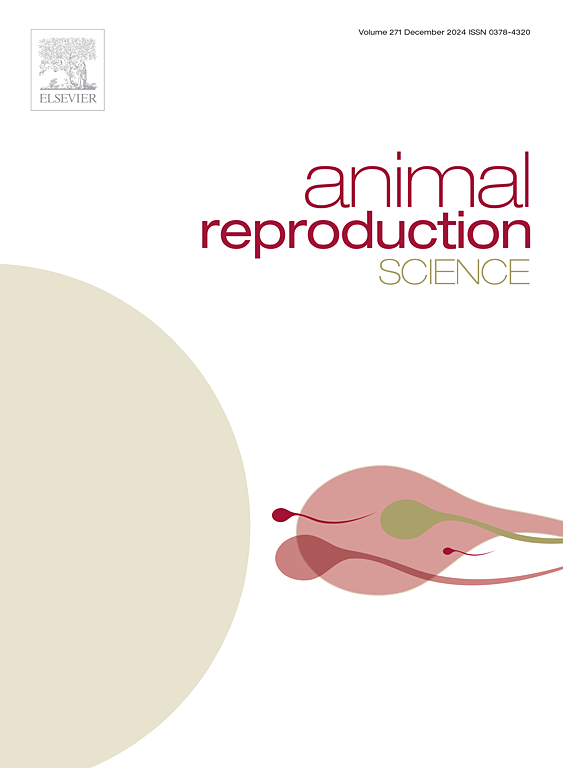基于水牛唾液蕨形态及其与受孕关系的最佳授精时机的确定
IF 3.3
2区 农林科学
Q1 AGRICULTURE, DAIRY & ANIMAL SCIENCE
引用次数: 0
摘要
唾液蕨图案(SFP)提供了一种简单、无创、经济高效的替代传统发情检测方法,解决了诸如静热、热检测不准确和人工授精(AI)时机不当等挑战。本研究评估了SFP在确定人工授精最佳时机方面的效用及其与水牛受孕的关系。进行了两个实验。实验1采用标准Ovsynch方案处理12头卵泡期循环水牛,系统采集168份唾液样本,建立黄体期和卵泡期的参考SFP及其等级和相应的分形维数值。实验2选用62头处于自然发情期的水牛,在不使用激素的情况下进行人工授精,在授精前采集唾液样本进行SFP分析。SFP根据显微观察和分形维值被分为优秀、良好、一般或差。在实验1中,在发情后期和发情早期观察到一个分形维数值较低(P <; 0.01)的优质SFP。在大约15 h,分级过渡到一个良好的等级,对应于发情晚期,然后下降到黄体期的一般或差等级。实验2中,SFP等级好的水牛受精率高于其他等级(P <; 0.01)。这些发现表明,在出现优质SFP后15 h或当SFP等级过渡到良好时(对应于发情后期),可以精确地对水牛进行人工智能受孕。这种方法可能有助于提高水牛的繁殖效率和解决发情检测的挑战。本文章由计算机程序翻译,如有差异,请以英文原文为准。
Determining the best timing of insemination based on salivary fern pattern and its association with conception in buffalo
Salivary fern patterns (SFP) offer a simple, non-invasive, and cost-effective alternative to conventional estrus detection methods, addressing challenges such as silent heat, inaccurate heat detection, and improper timing of artificial insemination (AI). This study evaluated the utility of SFP in determining best timing for AI and its association with conception in buffaloes. Two experiments were conducted. In Experiment 1, twelve cyclic buffaloes in follicular phase were treated with standard Ovsynch protocol and 168 saliva samples were systematically collected to establish reference SFP, its grades, and corresponding fractal dimension values across the luteal and follicular phases. In Experiment 2, 62 buffaloes in natural estrus were inseminated without hormonal treatment, with saliva samples collected prior to insemination for SFP analysis. The SFP were graded as excellent, good, fair, or poor based on microscopic observation and fractal dimension values. During Experiment 1, an excellent grade SFP with lower (P < 0.01) fractal dimension values was observed during late proestrus and early estrus. In about 15 h, the grading transitioned to a good grade corresponding to late estrus before declining to fair or poor grades in the luteal phase. In Experiment 2, buffaloes exhibiting a good grade SFP at insemination showed higher conception rates (P < 0.01) compared to other grades. These findings suggested a precision AI timing for improved conception in buffaloes at either 15 h after the appearance of an excellent grade SFP or when the SFP grade transitions to good, corresponding to late estrus. This approach may help enhance reproductive efficiency and address estrus detection challenges in buffaloes.
求助全文
通过发布文献求助,成功后即可免费获取论文全文。
去求助
来源期刊

Animal Reproduction Science
农林科学-奶制品与动物科学
CiteScore
4.50
自引率
9.10%
发文量
136
审稿时长
54 days
期刊介绍:
Animal Reproduction Science publishes results from studies relating to reproduction and fertility in animals. This includes both fundamental research and applied studies, including management practices that increase our understanding of the biology and manipulation of reproduction. Manuscripts should go into depth in the mechanisms involved in the research reported, rather than a give a mere description of findings. The focus is on animals that are useful to humans including food- and fibre-producing; companion/recreational; captive; and endangered species including zoo animals, but excluding laboratory animals unless the results of the study provide new information that impacts the basic understanding of the biology or manipulation of reproduction.
The journal''s scope includes the study of reproductive physiology and endocrinology, reproductive cycles, natural and artificial control of reproduction, preservation and use of gametes and embryos, pregnancy and parturition, infertility and sterility, diagnostic and therapeutic techniques.
The Editorial Board of Animal Reproduction Science has decided not to publish papers in which there is an exclusive examination of the in vitro development of oocytes and embryos; however, there will be consideration of papers that include in vitro studies where the source of the oocytes and/or development of the embryos beyond the blastocyst stage is part of the experimental design.
 求助内容:
求助内容: 应助结果提醒方式:
应助结果提醒方式:


